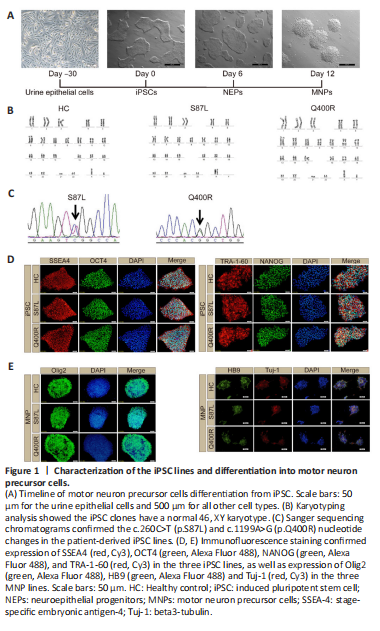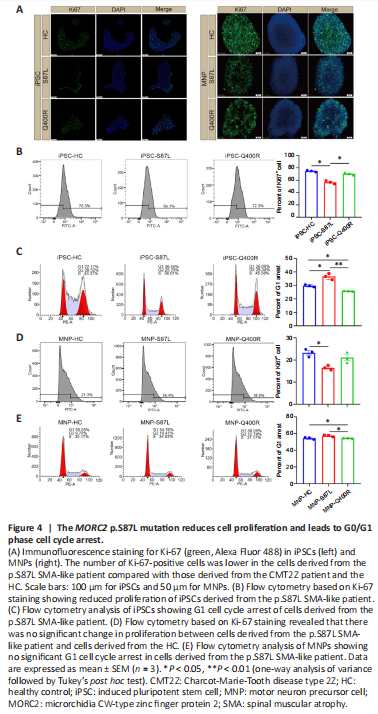神经退行性病
-
Figure 1|Characterization of the iPSC lines and differentiation into motor neuron precursor cells.

Urinary tract epithelial cells from one SMA-like patient (p.S87L), one CMT2Z patient (p.Q400R), and one HC were reprogrammed using non-integrative episomal plasmids to produce iPSC lines (Figure 1A). The iPSCs from the two patients and one HC had normal karyotypes (Figure 1B). Histological examination showed tumor formation after iPSCs injection, which demonstrated the in vivo pluripotency of the established iPSC lines (Additional Figure 1). The presence of MORC2 mutations in the two patients was confirmed by Sanger sequencing (Figure 1C). Immunofluorescence staining confirmed expression of the pluripotency-associated stem cell markers SSEA4, OCT4, NANOG, and TRA-1-60 in the three iPSC lines (Figure 1D). Twelve days after induction, the iPSCs were then differentiated into MNPs (Figure 1A). Immunofluorescence staining for the MNP marker Olig2 was observed in the differentiated MNPs, confirming their identity (Figure 1E).
Figure 4|The MORC2 p.S87L mutation reduces cell proliferation and leads to G0/G1 phase cell cycle arrest.

Studies have confirmed that the PI3K/Akt and MAPK/ERK pathways are involved in regulating cell proliferation, differentiation, and apoptosis (Zhang and Liu, 2002; Fresno Vara et al., 2004). We found that the p.S87L mutation suppressed activation of the PI3K/Akt and MAPK/ERK pathways, which could be involved in the pathogenesis of the SMA-like phenotype caused by p.S87L. However, the effect of downregulation of the PI3K/Akt and MAPK/ERK pathways on cellular phenotype remained to be explored. To assess cell proliferation and cell cycle progression, Ki-67 immunostaining, flow cytometry analysis of Ki-67-stained cells, and flow cytometry analysis of PI -stained cells were performed. The immunostaining results showed that the iPSC and MNP cells derived from the p.S87L SMA-like patient displayed less proliferation than those from the CMT2Z patient and the HC (Figure 4A). Flow cytometry analysis of Ki-67-tained cells further showed that, as compared with the HC, there were fewer Ki-67-positive iPSC cells derived from the p.S87L SMA-like patient (Figure 4B). Flow cytometric analysis of the PI-stained cells revealed that iPSCs derived from the p.S87L SMA-like patient were mainly blocked at the G1 phase, with a marked decreased in the percentages of cells in the G2 phase and S phase compared with iPSCs from the CMT2Z patient and the HC (Figure 4C). There was significantly reduced proliferation of MNPs derived from the p.S87L SMA-like patient compared with those derived from the HC (Figure 4D). However, there was no statistically significant change in cell cycle distribution between MNPs derived from the p.S87L SMA-like patient and those derived from the HC. Next, we asked whether activation of the MAPK/ERK and PI3K/Akt signaling pathways would affect the proliferation and cell cycle distribution of iPSCs derived from the patients with the MORC2 p.S87L mutation. DUSP6 (Li et al., 2007; Ekerot et al., 2008; Zhang et al., 2010) and PTEN (Carracedo and Pandolfi, 2008; Zhang et al., 2010) are classic negative regulatory molecules of the ERK and Akt signaling pathways, respectively. When siRNA-DUSP6 and siRNA-PTEN were used to directly activate these two signaling pathways, cell proliferation increased and G1 cell cycle arrest was reduced in iPSCs carrying the MORC2 p.S87L mutation (Additional Figure 3). Overall, our findings demonstrated lower cell proliferation, as well as G0/G1 phase cell cycle arrest, in iPSCs derived from the p.S87L SMA-like patient compared with the other donors, and lower cell proliferation in MNP cells derived from the p.S87L SMA-like patient compared with the other donors.
点击此处查看全文